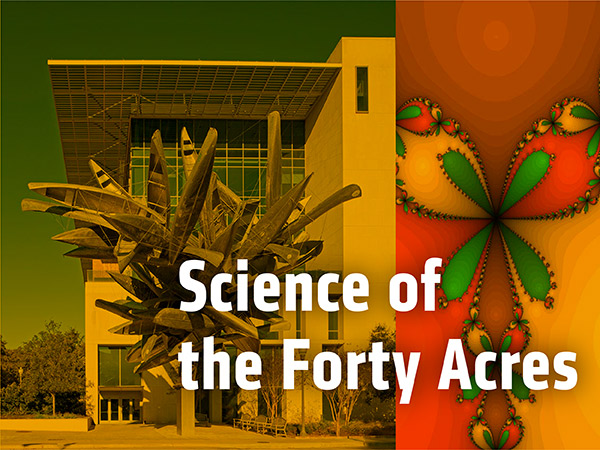The College's Campus Buildings
|
Visit the college virtually on our site with videos, 360 pics & "now & then" images. |
| On campus now? Take our mobile-phone guided walking tour of UT Natural Sciences » |
BIO Biological Laboratories
BOT Biological Greenhouse
FNT Larry R. Faulkner Nano Science and Technology Building
GEA Mary E. Gearing Building
GDC Bill & Melinda Gates Computer Science Complex & Dell Computer Science Hall
MBB Louise and James Robert Moffett Molecular Biology Building
NMS Neural Molecular Science Building
NHB Norman Hackerman Building
PAI T.S. Painter Hall
PAT J.T. Patterson Laboratories Building
PMA Physics, Math and Astronomy Building
SEA Sarah M. and Charles E. Seay Building
WEL Robert A. Welch Hall
WCH Will C. Hogg Building
Main UT Maps Website »
UT Parking Maps »
FIELD STATIONS
Brackenridge Field Laboratory
In the heart of Central Austin along the Colorado River, the 90-acre Brackenridge Field Lab provides easy access to natural experimental space for college biologists and ecologists and their students. The lab includes several ecosystems representative of Central Texas and state-of-the-art greenhouses.
Stengl "Lost Pines" Biological Station
Only 40 minutes east of Austin, the 208-acre Stengl "Lost Pines" Biological Station sits within the unique "Lost Pines" ecosystem near Smithville, Texas. The "Lost Pines" are a geographic outlier of Loblolly Pine (Pinus taeda) more than 120 miles west of the current limits of the species.
Lady Bird Johnson Wildflower Center
Located 10 miles south of downtown Austin, the Lady Bird Johnson Wildflower Center attracts millions of people with its mission to inspire the conservation of native plants through gardens, research, education, consulting and outreach programs. Officially designated the Botanic Garden and Arboretum of Texas, the center is free for UT students, faculty and staff with their UT ID and, as part of the college field station network, it offers opportunities to conduct unique research in a mixed oak-juniper savanna along the Balcones Escarpment with intermittent drainages and a network of cave and karst features.
MARINE SCIENCE INSTITUTE
This Marine Science Institute, perched on the shores of a Gulf Coast barrier island in Port Aransas, Texas, hosts the Department of Marine Biology. The department has full access to many unique marine ecosystems around the Gulf of Mexico and manages the Mission-Aransas National Estuarine Research Reserve, which encompasses 185,000 acres of coastal ecosystem.
MCDONALD OBSERVATORY
The McDonald Observatory is one of the world's leading centers for astronomical research, teaching, and public education and outreach. Observatory facilities are located atop Mount Locke and Mount Fowlkes in the Davis Mountains of West Texas, which offer some of the darkest night skies in the continental United States. Home to the Hobby-Eberly Telescope, Star Parties and StarDate radio.















